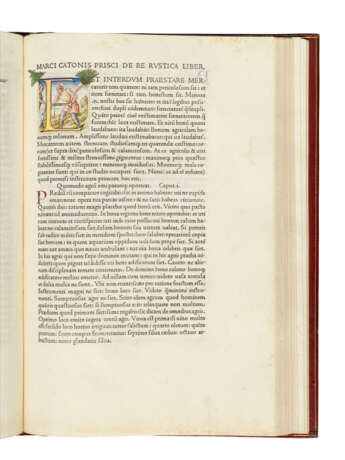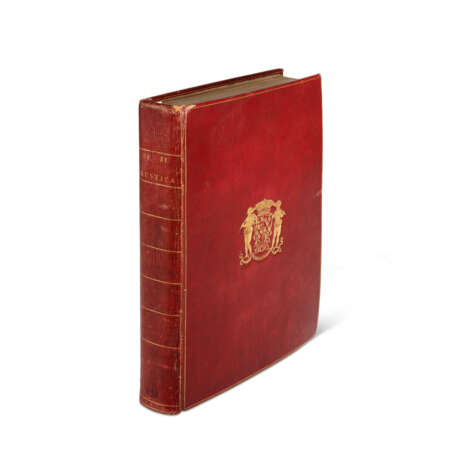ID 993249
Lot 120 | SCRIPTORES REI RUSTICA
Estimate value
£ 60 000 – 90 000
CATO, Marcus Porcius (232-147 BCE). De re rustica. - Marcus Terentius VARRO (116-27 BCE). De re rustica. - L.Junius Moderatus COLUMELLA (fl. c.36-c.65 CE). De re rustica. Edited by Georgius Merula (1430/1-1494). - Rutilius Taurus PALLADIUS (fl. 4th century). De re rustica. Edited by Franciscus Colucia (fl. 15th century). Venice: Nicolaus Jenson, 1472.
First edition of all texts, the chief works on agriculture and rural life, finely illuminated and with the arms of the dogal Priuli family of Venice. It deals with crops, vines, bees, olives, cattle-breeding, and – in Cato – old customs and superstitions to aid in effective cultivation. Only book ten of Columella had probably appeared already at Rome, (c. 1471; GW 7180). The most comprehensive work on Roman agriculture, it took up Vergil’s statement in the Georgics (4.148) that he was leaving it to others to write about gardening. Thus Columella’s tenth book is on gardens and written in hexameters to supplement Vergil, and it is the only part of the four texts in this collection to be printed independently in the 15th century. The conjunction of the three texts by Columella, Cato and Varro can be found from the Middle Ages, and their first appearance together in a manuscript, once in S. Marco but now lost, was the basis for this first edition and most 15th-century manuscripts. In it Varro breaks off after Bk. 3, ch. 17.4 as here. They are joined in this collection by Palladius, whose works survived antiquity in only one copy. The Priuli family counted Venetian Doges Lorenzo (1489-1559) and Antonio (1548-1623), as well as other dignitaries among its members. The illuminator of the present work was apparently the same artist who illuminated a Sallust, Venice 1474, sold in the Boies Penrose sale, Sotheby’s, 9 November 1971; the hand is close to that in Bodleian Auct. Q inf. 2.21 [Livy, Venice 1481; Pächt & Alexander II, 1970, Pr. 97, pl. LXXXVIII]). H 14564*; BMC V, 173; CIBN S-174; Flodr, Scriptores rei rusticae 1; IGI 8853; BSB-Ink S-232; Bod-inc. S-122; Klebs 902.1; Goff S-346; ISTC is00346000.
Median folio (326 x 22mm). 302 leaves, bound with Columella and Palladius texts first (quires 10-24) followed by Cato and Varro (quires 2-9) and Enarrationes brevissimae (quire 1) at end; the letter from Merula to Dominicus Georgius (variously bound in quire 2, 10, or 28) here on its own at front and slightly shorter, roman and Greek types, printed guide-letters, 4 large historiated initials in gold and colours with landscape backgrounds and some extensions by a Venetian artist (see above), contemporary illuminated arms of the Priuli family of Venice in lower margin of folio 7r, other 8-line outline initials in alternating blue, red or green, smaller initials in alternating red, blue and green (minor marginal spotting). English 18th-century red straight-grained morocco gilt, gilt arms of John, third Duke of Roxburghe on sides, gilt fillet border, smooth spine ruled in gilt fillet in 8 compartments, gilt-lettered in one compartment and with date at foot, gilt edges faintly gauffered (lightly rubbed at extremities). Provenance: Priuli family, Venice (arms on folio 8) – occasional neat marginal annotations in Columella margins – John, third Duke of Roxburghe (binding; sale, Evans, 27 May 1812, lot 1814) – George W. Fitzwilliam, Milton Hall, Peterborough (booklabel; sale, Sotheby's, 30 April 1918, lot 293) – C.S. Ascherson (1874-1945; bookplate) – Broxbourne Library (sale, Sotheby's London, 9 May 1978, lot 633) – British Rail Pension Fund (sale, Sotheby's London, 27 September 1988, lot 16) – An Important Botanical Library, Christie’s NY, 4 June 1997, lot 136.
Special notice
No VAT is payable on the hammer price or the buyer's premium for this lot. Please see the VAT Symbols and Explanation section of the Conditions of Sale for further information
| Place of origin: | Italy, Europe |
|---|---|
| Auction house category: | Antiquarian books, Printed books |
| Place of origin: | Italy, Europe |
|---|---|
| Auction house category: | Antiquarian books, Printed books |
| Address of auction |
CHRISTIE'S 8 King Street, St. James's SW1Y 6QT London United Kingdom | |
|---|---|---|
| Preview |
| |
| Phone | +44 (0)20 7839 9060 | |
| Buyer Premium | see on Website | |
| Conditions of purchase | Conditions of purchase |





